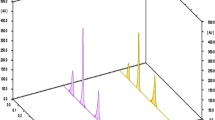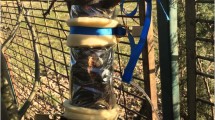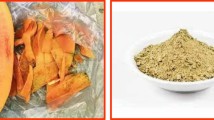Abstract
A MIXTURE of nitrated alkylphenols is made by various manufacturers in the United States, Great Britain, and The Netherlands, who then esterify it with crotonic or other acid for the preparation of fungicides useful in the control of powdery mildews and also spider mites on various crops. Fractionation of this mixture, hereinafter called DNOP, on alumina (Spence type ‘H’) in benzene, followed by 2 per cent methanol in benzene, followed by 1 per cent acetic acid in 49: 1 benzene–methanol, led to the isolation of three eluates1. From each of these, amine salts were prepared and analyses showed them all to be of dinitro-octylphenols; the melting points, however, showed them all to differ from each other and also from those of 2,4-dinitro-6-n-octylphenol and 2,6-dinitro-4-n-octylphenol2. The melting points of salts of eluate II, which formed not more than 5 per cent of any of the DNOP samples, were close to those of the corresponding salts of dinocap phenol (2,4-dinitro-6-(1-methylheptyl)phenol)1,3. As the biological activities (towards powdery mildews, spider mites, and host plants) of eluates I and II were similar, and those of eluate III were dissimilar, it appeared that eluate I, which formed about 60 per cent of one sample, was likely to be another isomer of dinocap phenol, and eluate III, which formed about 25 per cent of the same sample, an isomer of 2,6-dinitro-4-octylphenol other than the n-octyl or 1-methylheptyl1,3. The 1-ethylhexyl members of both series (2,4-dinitro-6-octylphenol and 2,6-dinitro-4-octyl-phenol) have therefore been synthesized, together with the 1-ethylpentyl and 1-ethylheptyl homologues, and the isomeric 2,6-dinitro-4-(1-propylpentyl)phenol. The ethylalkyl compounds were prepared by reaction of the appropriate alkyl magnesium bromide with o- or p-hydroxypropiophenone to give the o- or p-1-hydroxyalkylphenol, respectively4. Dehydration by refluxing with toluene and a few crystals of iodine under a Dean and Stark tube yielded the alkene, which was reduced catalytically (palladium charcoal) at about 50° C under 500 lb./in.2 pressure in 4–6 h to the 1-ethylalkylphenol. Nitration was done in glacial acetic acid, and the dinitro-(1-ethylalkyl)phenols isolated as various amine salts. Salts of the 2,4-dinitro-6-(l-ethylalkyl)phenols were easily recrystallized from benzene or methanol; those of the 2,6-dinitro-compounds required cyclohexene to give a tarfree product economically. The 2,4-dinitrophenols formed suitable salts with a greater range of amines than the 2,6-dinitrophenols. Melting points and analyses are given in Table 1.
This is a preview of subscription content, access via your institution
Access options
Subscribe to this journal
Receive 51 print issues and online access
$199.00 per year
only $3.90 per issue
Buy this article
- Purchase on Springer Link
- Instant access to full article PDF
Prices may be subject to local taxes which are calculated during checkout
Similar content being viewed by others
References
Kirby, A. H. M., Meded. LandbHoogesch. OpzoekStns Gent, 29, 976 (1964).
Dutton, G. G. S., Briggs, T. I., Brown, B. R., and Powell, R. K., Canad. J. Chem., 31, 837 (1953).
Kirby, A. H. M., Frick, E. L., Hunter, L. D., and Tew, R. P., Nitro Compounds, Proc. Intern. Symp., Warsaw, (1963).
Clarke, M., and Woodcock, D., J. Chem. Soc., 519 (1962).
Author information
Authors and Affiliations
Rights and permissions
About this article
Cite this article
KIRBY, A., HUNTER, L. Identification of Dinitro-octylphenols in Certain Commercial Fungicides. Nature 208, 189–190 (1965). https://doi.org/10.1038/208189a0
Issue Date:
DOI: https://doi.org/10.1038/208189a0
Comments
By submitting a comment you agree to abide by our Terms and Community Guidelines. If you find something abusive or that does not comply with our terms or guidelines please flag it as inappropriate.



